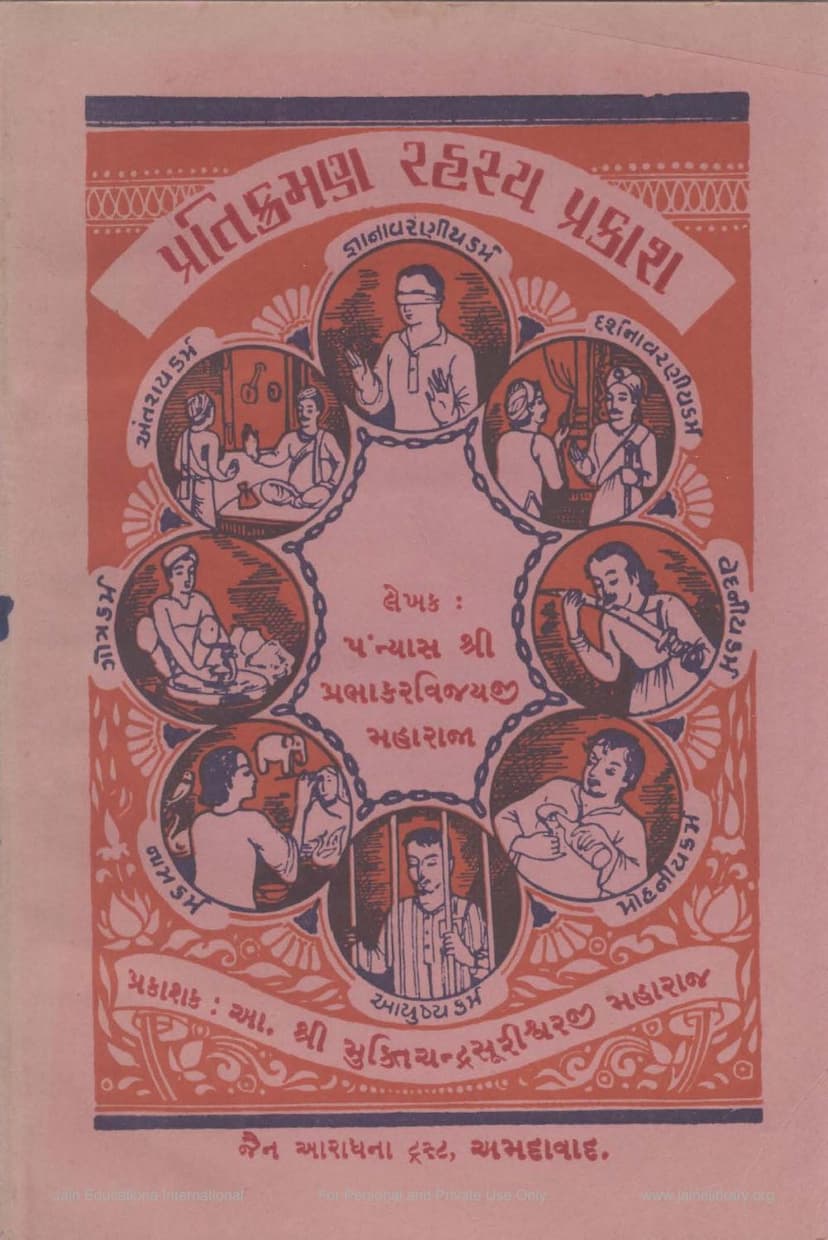Pratikraman Rahasya Prakash
Added to library: September 2, 2025

Summary
This is a summary of the Jain text "Pratikraman Rahasya Prakash" (The Light of the Mystery of Pratikraman) by Prabhakarvijay, published by Jain Aradhana Trust. The book is a detailed explanation and exploration of the Jain ritual of Pratikraman, which is a process of repentance, confession, and self-purification.
Here's a breakdown of the key themes and concepts covered in the text:
1. The Essence and Importance of Pratikraman:
- Pratikraman as a Path to Moksha: The book emphasizes that Pratikraman is an indispensable part of the path to liberation (Moksha). It is described as a means to keep the "three jewels" – right faith (Samyak Darshan), right knowledge (Samyak Gyan), and right conduct (Samyak Charitra) – pure and unbroken.
- Meaning of Pratikraman: The term "Pratikraman" is explained as "to return" or "to turn back." It signifies returning from attachment to external objects and states (Parabhav) to dwelling in one's true self (Swabhav).
- Spiritual Exercise: Pratikraman is presented as a comprehensive spiritual exercise that purifies the body, mind, and senses, making them conducive to the soul's true nature and enabling them to work for self and others' welfare.
- Overcoming Karma: The text stresses that Pratikraman helps in weakening and eventually eradicating the karmic bonds that keep the soul trapped in the cycle of birth and death.
2. Understanding Sin (Pap) and its Eradication:
- The Nature of Sin: Sin is described as an act that causes the soul to deviate from the path of liberation. It is a consequence of delusion (Moh), false beliefs (Mithyatva), and ignorance (Ajnan).
- The Harm of Sin: Engaging in sinful activities like violence, falsehood, theft, unchastity, dishonesty, greed, anger, pride, deceit, and envy is detrimental to the soul's progress and hinders its inherent qualities of infinite knowledge, perception, and conduct.
- The Role of Repentance: The book highlights the importance of acknowledging and repenting for sins committed, whether intentionally or unintentionally. This repentance, along with seeking forgiveness and undertaking penance (Prayschitt), is crucial for purification.
- The Analogy of Physical and Spiritual Injury: Just as a physical wound needs healing, a soul's "wound" caused by sin requires spiritual remedies like Pratikraman.
3. The Process and Components of Pratikraman:
- Six Essential Activities (Avashyak): Pratikraman encompasses six essential daily activities in Jainism:
- Samayik (meditation, equanimity)
- Chauvisthotho (paying reverence to 24 Tirthankaras)
- Vandana (salutations)
- Pratikraman (repentance)
- Kaussagg (abstinence from activity, self-reflection)
- Pachchakhan (vows, abstinence)
- Detailed Explanation of Samayik: The book elaborates on Samayik, describing it as a state of mental stillness and equanimity, where the mind is focused on the soul. It distinguishes between transactional Samayik (following the ritual) and essential Samayik (achieving true inner stillness).
- The Significance of Sutras: The text emphasizes the importance of reciting and understanding the Pratikraman sutras, often in Ardhamagadhi and Sanskrit. These sutras are considered powerful tools for spiritual purification.
- The Importance of "Vidhi" (Method/Procedure): The book repeatedly stresses the necessity of performing these rituals with proper methodology and reverence (Vidhi-Bahuman). Deviation from the prescribed method is considered detrimental to the effectiveness of the practice.
- The Role of Faith and Intention: True Pratikraman requires not just outward performance but also inner sincerity, faith, and a genuine desire for self-improvement.
4. The Deeper Meanings and Practices:
- Pratikraman as a Spiritual Discipline: The book delves into the underlying spiritual principles and practices associated with Pratikraman, including:
- Jaya (Victory): Overcoming one's own negative tendencies and passions.
- Upaga: Self-control and restraint.
- Mouna (Silence): Inner silence and stillness.
- Chintan (Contemplation): Deep reflection on the nature of the soul and the path to liberation.
- The Importance of Devotion (Bhakti): The text highlights how Pratikraman itself is a form of devotion to the Tirthankaras and the teachings of Jainism.
- The Role of Gurus and Scriptures: The book acknowledges the role of gurus and scriptures in guiding the practice of Pratikraman and understanding its deeper meanings.
5. Addressing Common Doubts and Criticisms:
- Pratikraman's Length and Engagement: The book addresses the perception that Pratikraman can be lengthy or boring, arguing that for a truly devoted soul, it is a source of immense joy and spiritual growth.
- The Efficacy of Pratikraman: It counters the idea that Pratikraman, being a ritual, might lack spiritual depth, asserting that when performed with the right intention and understanding, it is profoundly effective in purifying the soul.
- The Importance of Correct Pronunciation: The text stresses the importance of accurate pronunciation of the sutras, as even minor errors can alter the meaning and efficacy of the prayers.
6. The Goal:
- Cultivating Detachment: The ultimate aim of Pratikraman, as presented in the book, is to cultivate detachment from worldly pleasures and attachments, strengthen one's resolve to follow the path of dharma, and ultimately achieve liberation.
- Spiritual Transformation: It guides the reader towards a life of righteousness, self-discipline, and unwavering devotion, leading to spiritual transformation and the realization of the soul's true, pure nature.
In essence, "Pratikraman Rahasya Prakash" serves as a comprehensive guide, explaining the "why" and "how" of Pratikraman, making it accessible and inspiring for Jain practitioners to engage more deeply with this vital spiritual practice.